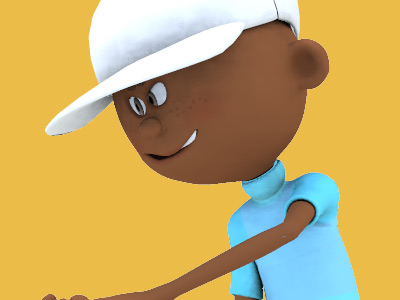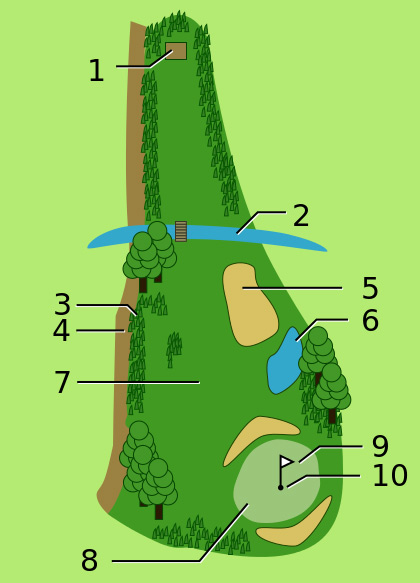Golf

Play of the Game
Every round of golf is based on playing a number of holes in a given order. A "round" typically consists of 18 holes that are played in the order determined by the course layout. Each hole is played once in the round on a standard course of 18 holes. The game can be played by any number of people. Though a typical group playing will have 1, 2, 3 or 4 people playing the round. The typical amount of time required for pace of play for a 9-hole round is two hours and four hours for an 18-hole round.
Playing a hole on a golf course is initiated by putting a ball into play by striking it with a club on the teeing ground (also called the tee box, or simply the tee). For this first shot on each hole, it is allowed but not required for the golfer to place the ball on a tee prior to striking it. A tee is a small peg that can be used to elevate the ball slightly above the ground up to a few centimetres high. Tees are commonly made of wood but may be constructed of any material, including plastic. Traditionally, golfers used mounds of sand to elevate the ball, and containers of sand were provided for the purpose. A few courses still require sand to be used instead of peg tees, to reduce litter and reduce damage to the teeing ground. Tees help reduce the interference of the ground or grass on the movement of the club making the ball easier to hit, and also places the ball in the very centre of the striking face of the club (the "sweet spot") for better distance.
When the initial shot on a hole is intended to move the ball a long distance (typically more than 225 yards (210 m)), the shot is commonly called a "drive" and is generally made with a long-shafted, large-headed wood club called a "driver". Shorter holes may be initiated with other clubs, such as higher-numbered woods or irons. Once the ball comes to rest, the golfer strikes it again as many times as necessary using shots that are variously known as a "lay-up", an "approach", a "pitch", or a "chip", until the ball reaches the green, where he or she then "putts" the ball into the hole (commonly called "sinking the putt" or "holing out"). The goal of getting the ball into the hole ("holing" the ball) in as few strokes as possible may be impeded by obstacles such as areas of longer grass called "rough" (usually found alongside fairways), which both slows any ball that contacts it and makes it harder to advance a ball that has stopped on it; "doglegs", which are changes in the direction of the fairway that often require shorter shots to play around them; bunkers (or sand traps); and water hazards such as ponds or streams.
In stroke play competitions played according to strict rules, each player plays his or her ball until it is holed no matter how many strokes that may take. In match play it is acceptable to simply pick up one's ball and "surrender the hole" after enough strokes have been made by a player that it is mathematically impossible for the player to win the hole. It is also acceptable in informal stroke play to surrender the hole after hitting three strokes more than the "par" rating of the hole; while technically a violation of Rule 3-2, this practice speeds play as a courtesy to others, and avoids "runaway scores", excessive frustration and injuries caused by overexertion.
The total distance from the first tee box to the 18th green can be quite long; total yardages "through the green" can be in excess of 7,000 yards (6,400 m), and when adding in the travel distance between the green of one hole and the tee of the next, even skilled players may easily travel five miles or more during a round. At some courses, electric golf carts are used to travel between shots, which can speed-up play and allows participation by individuals unable to walk a whole round. On other courses players generally walk the course, either carrying their bag using a shoulder strap or using a "golf trolley" for their bag. These trolleys may or may not be battery assisted. At many amateur tournaments including U.S. high school and college play, players are required to walk and to carry their own bags, but at the professional and top amateur level, as well as at high-level private clubs, players may be accompanied by caddies, who carry and manage the players' equipment and who are allowed by the rules to give advice on the play of the course. A caddy's advice can only be given to the player or players for whom the caddy is working, and not to other competing players.
SPORTS

RESOURCES
This article uses material from the Wikipedia article "Golf", which is released under the Creative Commons Attribution-Share-Alike License 3.0.
© Stories Preschool. All Rights Reserved.









